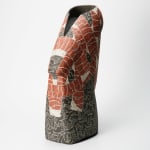Wada Morihiro 和太守卑良 1944-2008
Vessel "Kaku-Gen-Jho-Mon-Ki " 赫玄条文器, 1990's
Stoneware
H18 1/4 × W10 3/4 × D6 1/4 in.
H46.3 × W27.4 × D15.8 cm
H46.3 × W27.4 × D15.8 cm
With signed wood box
Further images
-
(View a larger image of thumbnail 1
)

-
(View a larger image of thumbnail 2
)

-
(View a larger image of thumbnail 3
)

-
(View a larger image of thumbnail 4
)

-
(View a larger image of thumbnail 5
)

-
(View a larger image of thumbnail 6
)

-
(View a larger image of thumbnail 7
)

-
(View a larger image of thumbnail 8
)

-
(View a larger image of thumbnail 9
)

-
(View a larger image of thumbnail 10
)

-
(View a larger image of thumbnail 11
)

-
(View a larger image of thumbnail 12
)

-
(View a larger image of thumbnail 13
)

-
(View a larger image of thumbnail 14
)

Under Tomimoto Kenkichi’s guidance at Kyoto Art University, all students were supposed to learn from and recreate nature in their work. In Wada’s hands, nature became abstract as plants, animals,...
Under Tomimoto Kenkichi’s guidance at Kyoto Art University, all students were supposed to learn from and recreate nature in their work. In Wada’s hands, nature became abstract as plants, animals, and natural forces became symbols and decorative elements, often combining into intricate abstract pattern. These patterns often rise from the repetition of abstracted natural form, becoming a unique expression of Wada’s particular view of the natural world. He used natural materials as much as possible, including different forms of clay, sand, and slip. He experimented with various colored natural clays that produce a variety of colors after high firing, including grey-green, dark auburn, purple, and navy. These Vessels he inlaid with white slip patterning, allowing the colorful clay to show through the inlaid lines in ever more complicated and intricate processes.
Wada’s work can be found at the Minneapolis Institute of Art; the Mint Museum, Charlotte, North Carolina; the New Orleans Museum of Art; the Newark Museum of Art, New Jersey; the Philadelphia Museum of Art; Faenza International Museum of Ceramics, Italy; Musée National de Céramique, Sèvres, France; Musée National de la Porcelaine Adrien-Dubouché, Limoges, France; the Victoria and Albert Museum, London; Musée Tomo, Tokyo; Kure Municipal Museum of Art, Hiroshima; Ogawa Museum of Art, Tokyo; Ibaraki Museum of Modern Art; Tokyo National Museum of Art; and the Tochigi Prefectural Museum of Fine Arts, as well as in numerous private collections.
Wada’s work can be found at the Minneapolis Institute of Art; the Mint Museum, Charlotte, North Carolina; the New Orleans Museum of Art; the Newark Museum of Art, New Jersey; the Philadelphia Museum of Art; Faenza International Museum of Ceramics, Italy; Musée National de Céramique, Sèvres, France; Musée National de la Porcelaine Adrien-Dubouché, Limoges, France; the Victoria and Albert Museum, London; Musée Tomo, Tokyo; Kure Municipal Museum of Art, Hiroshima; Ogawa Museum of Art, Tokyo; Ibaraki Museum of Modern Art; Tokyo National Museum of Art; and the Tochigi Prefectural Museum of Fine Arts, as well as in numerous private collections.













